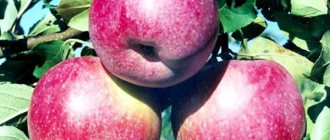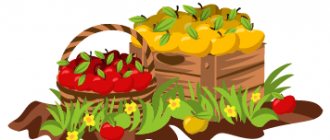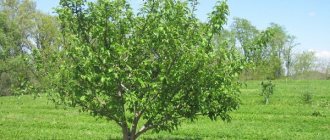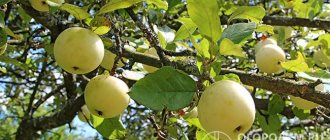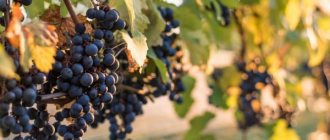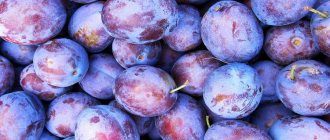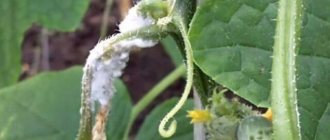Gardening » Apple tree
0
617
Article rating
Kira Stoletova
The Imrus apple tree is a hybrid obtained by crossing Antonovka vulgare with several winter-hardy varieties. The name is an abbreviation of the phrase “Russian immunity”, and the variety itself is popular among gardeners for its valuable qualities.
Apple tree variety Imrus
Description of the tree
The distinctive features of this variety of apple tree are the rough brown-green bark and the rounded shape of the spreading and rather dense crown. Only with age does this green tint disappear.
The trees are standard, and if they are formed from a seed rootstock, they can reach up to 6 m in height. With a dwarf rootstock (that is, obtained from a cutting), the height is less, up to 3 or 4 m.
The branches are elastic and relatively thin. The leaves are oblong with a curled tip, petiolate. The leaves are smooth and green on top, their surface looks wrinkled due to numerous veins. The edges are jagged.
Flowering is early, begins in May. The flowers are small, white and pink, collected in inflorescences of 5 or 6 pieces.
Important characteristics include:
- annual growth (about 10 cm);
- life span of a tree: with a seed rootstock the tree lives up to 80 years, with a clonal rootstock it lives much less.
Fruit
The Imrus apple reaches maturity by the end of September.
The fruits are yellow-green with a blush, medium size, weight from 130 to 180 g, slightly flattened shape. The peel is thin, easily damaged, and somewhat oily to the touch.
The pulp is very juicy, dense, greenish-cream in color, with possible pink inclusions. The structure is fine-grained. The taste is sweet and sour, the aroma is pronounced.
Compound
Apples contain many beneficial substances
Apples contain:
- vitamins (C, A, E, K, B1, B2, B3, B5, B6, B9);
- minerals (iron, copper, zinc, potassium, calcium, magnesium, sodium, phosphorus);
- pectins;
- organic sugars;
- organic acids;
- vegetable protein;
- unsaturated fatty acids;
- tannins;
- essential oils.
Productivity
The first harvest begins in 3-6 years (depending on the type of rootstock). The yield grows year by year (with proper tree care) and ranges from 30 to 100 kg per year.
Winter hardiness
The tree tolerates cold and even snowless winters, as well as early frosts.
Still, it is better to prepare them for winter: cover the trunk circles with a thick layer of humus, wrap the trunks with burlap, and cover the bottom with spruce branches (this is also protection from rodents).
Pollinators
According to the description, Imrus is pollinated by insects, but the apple tree is considered only partially self-fertile and needs pollinators that bloom at the same time (for example, Freshness, Veteran, Kandil Orlovsky, etc.).
Resistance to diseases and pests
The variety is genetically resistant to powdery mildew and scab - common fungal diseases of apple trees that are difficult to control.
However, there is no resistance to other diseases (black cancer, fire blight) and pests (apple sawfly, flower beetle, green aphid). Fortunately, all of the above disasters do not threaten apple trees with proper care.
Description of the apple variety Imrus
Imrus is a popular winter variety of apples, which was bred at the All-Russian Institute of Fruit Breeding. To obtain the variety, Antonovka vulgaris was crossed with a standard hybrid from winter varieties.
In 1988, Imrus seedlings were allocated to the elite class, after which they passed tests, entered the State Register of the Russian Federation and received a recommendation for cultivation in the Central and Central Black Earth regions of the Russian Federation and Belarus . Imrus, for example, is ideal for planting in the Moscow region with its temperate continental climate.
Apple trees of this variety at the age of four years can produce up to 22 kilograms of fruit
The tree of the variety grows up to 4–5 m and is distinguished by a rounded, spreading, medium-dense crown and greenish-brown trunk bark with pronounced peeling. The main branches are attached to the trunk at an acute angle and are capable of bending strongly. The branches of the variety are thin, elastic, drooping, with small conical buds.
The leaves have an elongated oval shape, serrated edges and special helical tips. The upper surface of the leaf is smooth, shiny, with slight wrinkles. Imrus blooms in early May with white flowers with a slight pink tint, collected in clusters of 5–6 inflorescences.
Imrus apples are perfect for fresh consumption, and are also often used for preparing winter preparations, including purees, compotes and juices.
Fruit characteristics
Imrus apples are oval, slightly ribbed, weighing 150–200 g. During harvesting, the fruits have a rich green tint, but during aging they gain consumer ripeness and become light yellow. The skin of the fruit is thin, glossy, without the waxy coating characteristic of many winter varieties. Small subcutaneous dots are clearly visible on it.
Important! When stored for a long time in a basement or cellar, apples should be placed away from other fruits. Because they secrete a substance that causes sprouting and aging of other fruits.
The pulp of the fruit of the variety is dense, juicy, fine-grained, creamy with a soft sour-sweet taste and a characteristic fruity smell. Expert assessment of the variety’s taste is 4.4 points, and its presentation is 4.3 points.
Pros and cons of the variety
- The Imrus apple tree has the following advantages:
- early fruiting and good yield;
- excellent resistance to frost;
- high resistance to scab;
- excellent product characteristics of apples;
- long-term preservation of fruits.
The disadvantages of the variety include only the thin skin on ripe fruits, which reduces their level of transportability.
Pollination
Imrus is a partially self-pollinating variety . As a result of selection, the viability of its pollen was in the range of 30–55%. That is, in the absence of third-party pollinators, no more than 20% of greenflies will form on the apple tree, so to unlock the full potential of the variety, it is necessary to plant other late-ripening apple trees in the neighborhood.
Winter varieties of apple trees also include:
Advantages and disadvantages
The Imrus variety will delight you with productivity
The Imrus apple tree variety has the following advantages:
- winter hardiness;
- genetic resistance to scab and powdery mildew;
- high productivity;
- excellent taste of the fruit.
The disadvantages include:
- the need to plant pollinators;
- thin peel (if damaged, the fruits will not be stored for long).
Subspecies and options
Columnar
A special place among early-fruiting apple tree varieties is occupied by a variety with a columnar shape.
These apple trees grow vertically upward and have no lateral branches . If they do form, they must be removed in the spring using pruning shears.
This tree is about 3 meters high and has a trunk covered with a large number of apples.
This subspecies is valued for the following characteristics:
- Abundance of harvest;
- Comfort during care;
- Exotic look.
Dwarf
Dwarf varieties are obtained by adding a rootstock to a regular seedling.
These varieties have gained popularity due to the following qualities :
- Early fruiting;
- Small size, which allows you to plant more trees on the site;
- Easy care;
- Saving on fertilizers.
Semi-dwarf
Semi-dwarf varieties are called apple trees that do not exceed a height of more than 2 meters.
An extremely prolific plant, but has a number of disadvantages :
- The plant is capricious;
- Requires careful care;
- Lifespan 10 years.
Landing Features
Dates and place
Young apple trees are planted in the spring, at the end of April, or in the fall, in late September or October.
In order for the tree to develop well and subsequently bear fruit abundantly, the seedlings need to be placed in a place well lit by the sun and not blown by much wind. In the selected area, groundwater should not come close to the soil surface.
If the soil is acidic, it needs to be adjusted to pH by liming.
Technology
Prepare a hole for planting in advance. Its diameter is about 80 cm, and its depth is at least 60 cm.
At the chosen location, the soil is dug deeply. The top fertile layer is mixed with a bucket of humus, half a bucket of peat and 1 tbsp. nitroammofoski.
Pieces of brick or gravel are placed at the bottom of the hole to ensure good drainage. A layer of soil mixed with fertilizers is poured onto the drainage, a seedling is installed and the roots are covered with the remaining soil.
In its final form, the seedling should be in a shallow hole, and the root collar should be 5-6 cm above the compacted soil.
The soil is covered in layers and each layer is compacted. A peg is also installed in the center of the pit, to which the seedling is tied. Afterwards it is watered generously.
Agricultural technology
Work on growing this ornamental plant should begin with a careful selection of seedlings. When purchasing, carefully inspect the roots - they should not be dry or damaged. They also carefully inspect the above-ground part - there should be no growths or stains on it.
The stem under the bark is bright green. The seedlings should be without foliage, and the buds should preferably not be swollen.
apple fruit
You need to buy two-year-old seedlings - in this case they will tolerate transplantation well and will not take long to adapt to new growth conditions.
Time to plant young trees:
- in the spring - until the third ten days of April (if frosts are no longer expected);
- in the autumn - until the second half of October.
In the second case, the planting time is calculated so that at least 1.5 months remain before the onset of cold weather. Only in this case will the plants have time to take root properly.
The place where these apple trees will grow should be well lit by sunlight, since in the shade or partial shade the color of the foliage will be less intense. As a result, the decorative effect of the plant will be partially lost.
Should be planted in a sunny area
The soil should not be too dry or waterlogged, so sandstone or heavy clay soil is not suitable for the Royalty apple tree. The best soil for planting is loamy or soddy-carbonate. The close occurrence of crushed stone, limestone and groundwater also negatively affects the growth of the root system.
Seedlings should also be prepared - their root system is placed in a bucket of water a day before. All damaged areas of the underground and above-ground parts of the tree should be removed, and the cut areas should be sprinkled with coal dust.
Preparing the planting hole:
- dig up 7-9 days before the intended planting;
- depth not less than 0.5 m;
- a layer of humus mixed with garden soil and sand in equal quantities is poured onto the bottom of the pit;
- add 2-4 liters of water.
Then the seedling is installed, and its roots are carefully straightened along the diameter of the hole. The roots are covered with soil from above, lightly compacted and watered with a bucket of water.
If more than two seedlings are planted, the distance between planting holes should be at least 6 m.
Interesting! Landscape designers advise planting barberry, lilac bushes, and fieldfare next to the decorative apple tree. And in the foreground bushes of peonies, irises and daisies will look good.
Further care consists of regular watering, loosening the tree trunks and removing weeds. The first watering is done when planting plants - at least half a bucket of water is poured under each tree. The next watering is carried out after 3 days, and then regularly once every 7 days. You should loosen the soil and remove weeds immediately after watering.
Important! Reproduction is carried out by grafting buds or shoots from the mother tree, in which case all species characteristics will be preserved. When grown from seeds, a new plant may not retain its maternal qualities.
Tree care
Watering and tillage
The soil under the trees must be loosened
The first year the seedling is watered as the top layer of soil dries. In subsequent periods - only in very hot times and during the period of bud formation.
Water in the morning and evening, and not during the sun. Standard: at least 2 buckets of water per day for each tree. Old, spreading trees require up to 10 buckets per day.
The ground under the tree should be periodically loosened and any weeds should be pulled out.
It is also recommended to mulch the soil under the apple tree. This protects it from drying out, and in harsh weather conditions it also protects the root system from hypothermia.
Top dressing
In the spring, usually from the 3rd year after planting, they are fed with complex fertilizer, for example, nitroammophoska. 1 tbsp. Fertilizers are diluted in a bucket of water and applied under one apple tree.
In the fall, feed optionally if the harvest was especially abundant. One tree is fertilized with a mixture: 0.5 kg of wood ash, 1 tbsp. superphosphate and 1 tbsp. potassium salt.
Crown trimming
Pruning is performed annually, even before the buds open, that is, in early spring. This helps to increase the yield and quality of the fruit.
Branches that thicken the crown and interfere with its uniform illumination should be removed. In addition, you need to remove all non-viable (dried, broken) branches.
Protection from diseases and pests
In the spring, the trunks of apple trees up to the point of origin of the lower skeletal branches are certainly whitened with lime - this is an effective protection against many pests and fungal spores.
Also, to protect against codling moth caterpillars, trees are equipped with hunting belts.
It is necessary to regularly inspect apple trees for damage and the presence of pests. If damaged branches or bark are noticed, the lesions are treated with disinfectants. This is the best prevention of the development of black cancer or bacterial burn.
- Regular digging of the soil around trees will protect against the apple sawfly.
- Frequent spraying with an infusion of dandelion or tobacco roots helps against aphids.
- Prevention of pest damage is also considered timely removal of fallen leaves.
Disease and pest control
Moderate watering, timely pruning, and fertilizing will minimize the damage to the apple tree by diseases. Treating trees for ailments comes down to regular garden care. If signs of disease still appear on the Imrus apple tree, it is necessary to treat the tree with disinfectants.
The Imrus apple tree is liked not only by gardeners. It is often favored by parasites. Pest control methods:
- fight the apple blossom beetle with a lime solution. The plant is sprayed once a week;
- The apple sawfly is dangerous for the crop. It is important to regularly dig up the soil in the root circle and carry out preventive spraying with copper sulfate;
- You can fight aphids with a soap solution or a solution of soda ash. If this does not help, proceed to the use of insecticides - Twix, Confidor Maxi, Aktara.
It is not recommended to spray trees with insecticides and fungicides during fruit ripening.
Features of ripening and fruiting
Fruiting begins at different ages, depending on the rootstock. With clonal varieties - in the third year, and with seed varieties - in 5 or 6 years. As already emphasized in the description of the variety, the yield increases from year to year.
Imrus is an autumn variety. Apples ripen by the end of September. Some of them fall from the tree spontaneously. Therefore, it is undesirable to postpone harvesting.
Fruiting is annual, but if for several years, with a bountiful harvest, autumn fertilization is neglected, the yield may decrease.
Agricultural technology
The most appropriate timing for planting the Sun:
- spring, when the buds have not yet bloomed;
- autumn period, after leaf fall, but before frost.
The technology used includes site selection. It should be sunny, with any soil except clay types of soil. Planting involves preliminary preparation of a hole, 0.8 m deep and 1 m in diameter, several weeks in advance. The tree is soaked in water, soaking the roots with moisture. The bottom must be filled with drainage, onto which soil is poured. A mound is formed in the middle of the hole, onto which the root system is installed and straightened. Pour and compact the rest of the soil, inserting a support for the plant, and water it abundantly.
Attention! It is very important to place the root collar a few cm above the surface for proper growth. When planting several apple trees, you need to maintain a distance of up to 6 meters between them. If the specimen is on a dwarf rootstock, then up to 3 meters
Watering should be moderate, without excess moisture, which will have a bad effect on the harvest. In autumn it is not required at all, and during hot periods - often, but not in large portions, in the evening. In rainy summers, the tree trunk is loosened and grooves are made to drain excess moisture
If the specimen is on a dwarf rootstock, then up to 3 meters. Watering should be moderate, without excess moisture, which will have a bad effect on the harvest. In autumn it is not required at all, and during hot periods - often, but not in large portions, in the evening. In rainy summers, the tree trunk is loosened and grooves are made to drain excess moisture
When planting several apple trees, you need to maintain a distance of up to 6 meters between them. If the specimen is on a dwarf rootstock, then up to 3 meters. Watering should be moderate, without excess moisture, which will have a bad effect on the harvest. In autumn it is not required at all, and during hot periods - often, but not in large portions, in the evening. In rainy summers, the tree trunk is loosened and grooves are made to drain excess moisture.
Agricultural technology is similar to other fruit crops:
- After wintering, the tree is inspected and diseased branches are found;
- In the spring, the tree is pruned and the crown is formed;
- Prevent diseases and pests;
- Watering;
- Weed removal, loosening, mulching;
- Application of fertilizers;
- Pruning in autumn.
Crown care measures involve the first pruning to 1/3 of the height after planting, in order to develop lateral branches. In the future, the procedure is carried out 2 times a year. In the spring, it provides conditions for the ripening of apples, as well as prevention from diseases and pests. In autumn, branches damaged by the harvest and its harvesting are removed.
Care also requires the application of fertilizers containing nitrogen and organic matter during the development of shoots. In the spring they feed with chicken droppings and ammonium nitrate. When fruiting, compost and superphosphate are added. In the fall, mineral complexes are added to tree trunk circles or holes.
Apple tree care
The issue of wintering the tree also deserves attention, although the variety is quite resistant to cold. Good tolerance to low temperatures is determined by proper soil moisture and fertilizing. For apple trees less than 5 years old, it is recommended to carry out warming measures. The space around the trunk is mulched, the roots are treated with superphosphate in the amount of 30 g per liter.
How to collect and preserve the harvest
Fruits must be carefully removed from the tree
It is best to pick apples while they are green. During subsequent storage they turn yellow.
Picked ripe fruits are stored until February. It is not recommended to throw picked fruits; you need to carefully place them in a container for collection.
The fruits are stored in ventilated wooden boxes in a cool, dark room (basement), preferably separately from other vegetables. Neighborhood with apples has a bad effect on the preservation of potatoes: they germinate faster. This occurs from the release of ethylene gas.
The collected fruits tolerate transportation well, if you do not shake or throw the boxes during loading and unloading.
Reviews
Ulyana, 23 years old, Novosibirsk: “We have several different types of apple trees on our site, Imrus is one of them. Apples are very tasty, I love them fresh and make charlotte or pies. And those that are intact and collected on time, I put in the cellar for storage.”
Nikolai Petrovich, 47 years old, Krasnoyarsk region: “The apple tree is small, very neat and beautiful. I never had any problems with her, never got sick or cold. I recommend Imrus for growing to everyone.”
Regional characteristics of cultivation
The variety is ideal for regions with a temperate continental climate, for example, the Moscow region.
This is not surprising: it was bred precisely for such climatic conditions. It is recommended to insulate the trunk and root soil in winter.
The same can be said about preparing apple trees for winter in southern Siberia. There is information about their cultivation even in the south of the Krasnoyarsk Territory. The climate in this area is sharply continental, and, in addition to the winter cold, the trees have to endure a hot summer. Watering must be adequate.
In the Leningrad region this variety takes root, but with difficulty, because soils are poor. But enthusiasts still get harvests by artificially enriching the soil.
In Belarus, Imrus has long been zoned in many regions; apple trees grow and bear fruit very well here.
Basic information about the variety
Imrus is a variety of winter apples, bred by crossing the well-known Antonovka variety with frost-resistant winter hybrids. Selection work on the development of Imrus apples began in 1977 at the Research Institute for Breeding Fruit Crops, where for almost 10 years the variety was tested for the main indicators: winter hardiness, immunity to disease, and yield.
Since all the indicators turned out to be excellent, in 1989 the Imrus variety was accepted for state testing, as a result of which 7 years later (in 1996) it was included in the State Register of varieties intended for industrial cultivation.
The hybridization process was complex and lengthy. Dozens of winter-hardy apple tree species over 10 years old were selected for crossing, of which seven experimental specimens were isolated. By repeatedly pollinating the varieties with each other, the seeds of this hybrid were obtained. Further, after stratification, the seed material was planted in the soil, where the Imrus hybrid developed using the “mentor method” (developed by I.V. Michurin).
To give apple trees frost resistance, their experimental cultivation took place in a cold climate, so the variety has a high immunity to cold and can grow even in extremely harsh weather conditions. The hybrid is also resistant to many diseases, especially powdery mildew and scab. Today, the Imrus variety is zoned in the Central Black Earth and Central regions of Russia, as well as in several regions of Belarus.
Harvest on time
| Stage 1. Treat the soil around the apple tree Loosen the tree trunk circle at least once every 2 months. Dig with half a shovel and remove grass and weeds. Mulch the surface with any suitable composition . Peat, humus, straw or grass clippings, sawdust and even pine cones will do. | |
| Stage 2. Water if there is no rain for a long time Use warm water, work in the evening or early in the morning. Watering is required if there has been no precipitation for more than 2 weeks. Pour from 5 to 10 buckets under each tree, depending on the size . The degree of dryness of the soil is also taken into account | |
| Stage 3. Feed twice a season Apply fertilizer in spring and autumn. It is best to combine the work with loosening the tree trunk circle so that nutrients quickly reach the roots. In spring it is better to use a mineral complex for fruits . In autumn, organic matter is preferable so that the tree can better withstand frost. | |
| Stage 4. Form the crown In the first years, follow the scheme. It is important to set the correct shape of the future tree. Continue pruning as necessary . In spring, remove damaged and broken branches. Shoots that thicken the crown are also cut out | |
| Stage 5. Remove apples correctly For storage, collect fruits unripe. Pluck and fold carefully so as not to damage the peel. Ripe fruits are used for processing and consumption . They don't last that long |
Preparing for the winter season
As mentioned above, the variety has unique frost resistance and is not afraid of spring temperature changes. Therefore, in preparation for the winter season, it is enough to carry out planned autumn work.
Harvest and storage
Harvesting begins in mid-September, at which time the apples reach technical maturity. After 30-40 days, the taste of apples is fully revealed, and they are ready for fresh consumption.
Fruit picking should be done during the day in warm and dry weather. Since the fruits of the “Imrus” variety have a very thin skin, they are removed exclusively by hand, trying to preserve the stalk. Place the apples in disinfected wooden boxes lined with food paper. Each layer is separated by a paper layer.
The fruits laid in this way are moved to a room with a temperature of +2 +5°C. You can store apples without loss of taste until February. Subsequently, they lose their characteristic elasticity and juiciness.
History of apple breeding
The Imrus variety was bred in 1977 by crossing 2 varieties : Antonovka ordinary and a hybrid form of winter ripening QR18T13. The hybridization method involved adult mother trees being pollinated by the paternal variety.
The variety was obtained by V.V. Zhdanov, E.N. Sedov, Yu.I. Khabarov and Z.M. Serova.
Due to the introduction of the V-6 gene into the tree’s immune system during the selection process, it received increased resistance to certain diseases, for example, scab.
Maintain distances from fences and other trees
| Stage 1. Select a quality seedling It is better to purchase from a nursery or store that is trustworthy. Markets, buying from hands is undesirable; it is unknown what you will get in the end. Inspect the seedlings carefully . There should be no damaged, broken or diseased areas | |
| Stage 2. Prepare the place Find a well-lit area with deep groundwater. The distance to the fence must be at least 2 meters. Retreat from neighboring trees and buildings at least 4, and preferably 5 meters. Dig a hole 60 cm deep . The diameter is usually made 80 cm, but may vary depending on the size of the root system | |
| Stage 3. Add the nutrient composition to the hole Use a mixture of 10 parts humus and 1 part wood ash. You can also add a mineral complex for apple trees. Place at least 2 buckets in the hole . Spread evenly over the bottom and stamp down | |
| Stage 4. Land Position the tree so that the grafting site is at least 5 cm above ground level. Straighten the roots so that they do not bend. Cover the root part with soil . It is good to compact the surface so that there are no voids left inside. | |
| Stage 5. Water the tree Use warm water for work. Pour out 3-4 buckets after planting. When the moisture has been absorbed, cover the surface with dry soil, as in the example in the photo. Pour out 2 buckets of water once a week . Carry out this work for a month and a half |
What type does it belong to?
Imrus - autumn apples . The time of its maturity falls in September.
The main disadvantage of apples is their thin peel. This feature makes it difficult to transport apples and store them.
The picked fruits are preserved for quite a long time.
To store apples, choose a dark, cool place.
Apples will keep well in a wooden box.
IMPORTANT: apples should not be stored in plastic bags. Due to the lack of air access, moisture forms in the bags, which will accelerate rotting.
